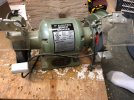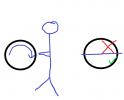It should go without saying, but wear safety glasses and a respirator. Lock your elbows at your side and make sure your buffer is at a comfortable height, so that you're not overextending yourself, or straining in any way while buffing. Use a similar stance as you would while grinding.
Wear a heavy apron.
An anti-fatigue mat below the buffer can help reduce the chance of a "ricochet" off the floor.
Let the buffing compound do the work. Try not to push your work through to the other side of the buff.

Loose sewn buffs tend to be more grabby than spiral sewn, though they can BOTH grab.
Use the bottom front quarter of the wheel for buffing. You have far more control if the buff is "pulling" your work down than if it's pushing it towards you.
Keep the area around your buffer clean and clear. If it's mounted on a bench, don't pile things beside or behind it that could vibrate into the buffs and get thrown across the shop. If you can mount to a pedestal, even better.
If you're buffing an edge (or a knife/tool with an edge) always buff edge down and watch your points or other sharp areas that can grab. Keep a firm grip.
One trick is to screw a blade blank to a larger and/or longer board and then buff it. Just make sure it's secure, then use the board as your handle. If you're buffing small parts, hold them in a pair of pliers or a hand vise. Just make sure it's not going to come out. I like using a Knipex pliers wrench, as they have smooth, parallel jaws that don't mar finishes very easily, and you get a 10:1 mechanical holding advantage.
Never get complacent, and don't buff when you're tired.
Some things in life are a matter of "when" not "if". I DON'T think getting hurt on a buffer is one of those things, as long as you respect the tool, understand its tendencies and limitations, and be intentional when your working with it. There's plenty of other things I worry about hurting or killing me in my shop before my buffers.



